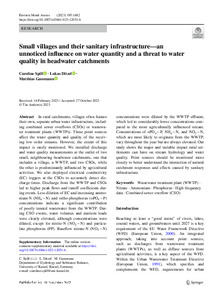| dc.date.accessioned | 2023-12-01T14:18:49Z | |
| dc.date.available | 2023-12-01T14:18:49Z | |
| dc.date.issued | 2023-11-16 | |
| dc.identifier | doi:10.17170/kobra-202311309139 | |
| dc.identifier.uri | http://hdl.handle.net/123456789/15254 | |
| dc.description.sponsorship | Gefördert im Rahmen des Projekts DEAL | ger |
| dc.language.iso | eng | |
| dc.rights | Namensnennung 4.0 International | * |
| dc.rights.uri | http://creativecommons.org/licenses/by/4.0/ | * |
| dc.subject | wastewater treatment plant (WWTP) | eng |
| dc.subject | nitrate | eng |
| dc.subject | ammonium | eng |
| dc.subject | phosphorus | eng |
| dc.subject | high-frequency data | eng |
| dc.subject | combined sewer overflow (CSO) | eng |
| dc.subject.ddc | 500 | |
| dc.subject.ddc | 540 | |
| dc.title | Small villages and their sanitary infrastructure—an unnoticed influence on water quantity and a threat to water quality in headwater catchments | eng |
| dc.type | Aufsatz | |
| dcterms.abstract | In rural catchments, villages often feature their own, separate urban water infrastructure, including combined sewer overflows (CSOs) or wastewater treatment plants (WWTPs). These point sources affect the water quantity and quality of the receiving low order streams. However, the extent of this impact is rarely monitored. We installed discharge and water quality measurements at the outlet of two small, neighbouring headwater catchments, one that includes a village, a WWTP, and two CSOs, while the other is predominantly influenced by agricultural activities. We also deployed electrical conductivity (EC) loggers at the CSOs to accurately detect discharge times. Discharge from the WWTP and CSOs led to higher peak flows and runoff coefficients during events. Less dilution of EC and increasing ammonium-N (NH₄ − N) and ortho-phosphorus (oPO₄ − P) concentrations indicate a significant contribution of poorly treated wastewater from the WWTP. During CSO events, water volumes and nutrient loads were clearly elevated, although concentrations were diluted, except for nitrite-N (NO₂ − N) and particulate phosphorus (PP). Baseflow nitrate-N (NO₃ − N) concentrations were diluted by the WWTP effluent, which led to considerably lower concentrations compared to the more agriculturally influenced stream. Concentrations of oPO₄ − P, NH₄ − N, and NO₂ − N, which are most likely to originate from the WWTP, vary throughout the year but are always elevated. Our study shows the major and variable impact rural settlements can have on stream hydrology and water quality. Point sources should be monitored more closely to better understand the interaction of natural catchment responses and effects caused by sanitary infrastructure. | eng |
| dcterms.accessRights | open access | |
| dcterms.creator | Spill, Caroline | |
| dcterms.creator | Ditzel, Lukas | |
| dcterms.creator | Gaßmann, Matthias | |
| dc.relation.doi | doi:10.1007/s10661-023-12051-6 | |
| dc.subject.swd | Kläranlage | ger |
| dc.subject.swd | Nitrate | ger |
| dc.subject.swd | Ammoniumverbindungen | ger |
| dc.subject.swd | Phosphor | ger |
| dc.subject.swd | Wassergüte | ger |
| dc.subject.swd | Mischkanalisation | ger |
| dc.subject.swd | Abwasser | ger |
| dc.type.version | publishedVersion | |
| dcterms.source.identifier | eissn:1573-2959 | |
| dcterms.source.issue | Issue 12 | |
| dcterms.source.journal | Environmental Monitoring and Assessment | eng |
| dcterms.source.volume | Volume 195 | |
| kup.iskup | false | |


